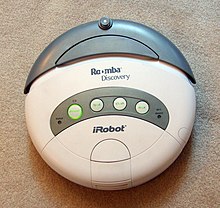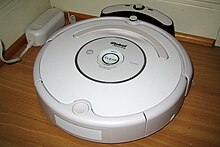Roomba
This article needs additional citations for verification. (June 2008) |

The Roomba is a robotic vacuum cleaner made and sold by iRobot. The Roomba was first released in 2002; updates and new models have been released every year since. As of January 2008, over 2.5 million units have been sold.
Description

The unit is a disc, 13.4 inches (34 cm) in diameter and less than 3.5 inches (9 cm) high. A large contact-sensing bumper is mounted on the front half of the unit, with an infrared sensor at its top front center. A carrying handle is fitted on the top of the unit. Depending on the model, it may come with between one and three "Virtual Wall" infrared transmitter units.
There have been three generations of Roomba units: The original Roomba, Pro, and Pro Elite; the second-generation "Discovery" series with a larger dustbin, dirt detection, and optional home base; and the newest 5xx series.
The Roomba operates with internal nickel-metal hydride batteries and must be recharged regularly from a wall plug, although newer second- and third-generation models have a self-charging homebase they automatically try to find (via its infrared beacon). Charging on the homebase takes about three hours. All second- and most third-generation Roombas can be used with the homebase, even if they do not come packaged with it. First- and second-generation models came packaged with a twelve-hour charger, although a three-hour rapid charger could also be used with them.
First-generation models needed to be told the size of the room via three room size buttons (Small, Medium, and Large), but this is no longer required with second and third-generation models.
Operation
Using a second- or third-generation Roomba consists of carrying it to wherever the owner would like it to start, pressing the "power" button, then pressing the "clean", "spot", or "max" (if applicable) button. Third-generation Roombas no longer have the "max" button, but include a "dock" button allowing the owner to instruct the Roomba to dock with its homebase. A second- or third-generation Roomba may also be used with the Scheduler accessory. It allows the Roomba to begin cleaning automatically at the time of day that the owner desires. This can be useful for people who want the Roomba to clean while they are at work.
When the "clean", "spot", or "max" button is pressed, the Roomba begins its work. The contact bumper detects bumping into walls and furniture, and the Virtual Walls limit the Roomba to the areas that the owner desires with an infrared signal. Special Scheduler Virtual Walls can be programmed to turn on at the same time the Scheduler-enabled Roomba is activated. Four infrared sensors on the bottom of the unit prevent it from falling off ledges. Second- and third-generation models have additional dirt sensors that allow them to detect particularly dirty spots and focus on those areas accordingly.
Unlike the Electrolux Trilobite vacuuming robots, Roombas do not map out the rooms they are cleaning. Instead, they rely on a few simple algorithms such as spiral cleaning, wall-following and random walk angle-changing after bumping into an object or wall. This design is based on MIT researcher and iRobot CTO Rodney Brooks' philosophy that robots should be like insects, equipped with simple control mechanisms tuned to their environments. The result is that although Roombas are effective at cleaning rooms, they take several times as long to do the job as a person would, usually covering some areas many times and others only once or occasionally not at all.
After a certain amount of time (in "clean" mode, third-generation models automatically calculate the time based on the amount of dirt detected and the longest straight-line run they can perform without bumping into an object, while first and second-generation models must be told the room size), the Roomba stops and sings a few triumphant notes. If a homebase is detected, a second- or third-generation Roomba will try to return to it. The owner then removes the dustbin from the unit's rear and empties it into a trash can. With the exception of the first-generation Roomba, an infrared remote control can also be used to control the unit, which is useful for a disabled person.
The Roomba is not designed for deep-pile carpet. It is low enough to go under a bed or other furniture. If at any time the unit senses that it has become stuck (on rug tassels, for example), it no longer senses the floor beneath it (it has been picked up), or it decides that it has worked its way into a narrow area from which it is unable to escape, it stops and sounds a mournful tone to help its owner find it.
Roomba Budget models (Dirt Dog and Model 401) have a simplified interface (a single "Clean" button) and lack some of the program generated flexibility of other versions. They are positioned to be less expensive versions of the Roomba for first-time purchasers. The Roomba Dirt Dog contains sweeping brushes and a larger dust bin but lacks the vacuum motor. It uses the space required for the vacuum for additional dust bin volume. It is designed for home shop or home garage environments. The Roomba Model 401 is similar but has a 'standard' size dust bin and vacuum system. They are compatible with the extended-life batteries, fast charger and schedulers of the Discovery series.
Models

The first-generation Roombas have three buttons for room size.
The second-generation Roombas (dubbed "Discovery") replaced their predecessors in July of 2004, adding a larger dust bin, better software that calculates room sizes, fast charging in the home base (or wall hanger in the Discovery SE), and dirt detection. All second-generation Roombas are functionally identical, though some have more or fewer buttons, accessories, or casings, and all featured updated programming after mid 2005. The low-end models continue to be available as of 2007 with new model names. All 2G Roombas can be updated to 2.1G Roombas.

The third-generation 5xx Roomba was introduced in 2007 and features an infrared sensor to detect obstacles, a dock button, and improved mechanical components.[1] Some second-generation models remain on sale, however, as the 4xx series.
Accessories
- Easy Clean Brush: A brush better designed to tackle pet hair, and is easier to clean (standard on "for pets" models).
- Remote Control: Control the Roomba remotely (for all second and third generation Roombas).
- iRobot Scheduler: Program your Roomba to clean around your schedule, even when you’re out. Schedule Upgrade accessory will also update a pre-2.1 Roomba to the 2.1 software (for all third generation Roombas).
- Homebase: The Roomba automatically returns to this for recharging (for all second and third generation Roombas).
- Virtual Wall: Used for keeping the Roomba out of certain areas (for all Roombas).
- Virtual Wall Lighthouse: Functionality of Virtual Wall in addition to 'Lighthouse' mode which will contain Roomba in one room until the room is completely vacuumed before moving on to the next.
- OSMO: A dongle that attaches to the serial port on the Roomba. This updates a pre-2.1 Roomba's firmware to version 2.1 and can also correct the "circle dance" problem (for all second generation Roombas).
- Advanced Power System (APS) Battery: Rechargeable battery for all Roomba models, that enable Roomba to clean for up to 200 minutes.
Programming
Roombas manufactured after October 2005 or upgraded with the Roomba OSMO//hacker contain an electronic and software interface that allows you to control or modify Roomba's behavior and remotely monitor its sensors. The iRobot Roomba Open Interface, previously known as the Roomba Serial Command Interface, is intended for software programmers and roboticists to create their own enhancements to Roomba. Various hardware interface devices are available to access the Roomba using the Roomba Open Interface and some projects are described on Roomba hacking sites. In response to this activity iRobot created the iRobot Create, which is a programmable robot of similar size and shape to the Roomba.
See also
References
External links
- iRobot, manufacturer and US retailer of Roombas
- iRobot Home Robot Community, official forums.
- Roomba Review Forums The largest and most active discussion site for Roomba users
- Robotic mapping for Roomba.
- RoombaDevTools.com, provides development tools to use roomba as a robotic base
- C# RoombaSCI, Open Source C# Programming Framework for Roomba
